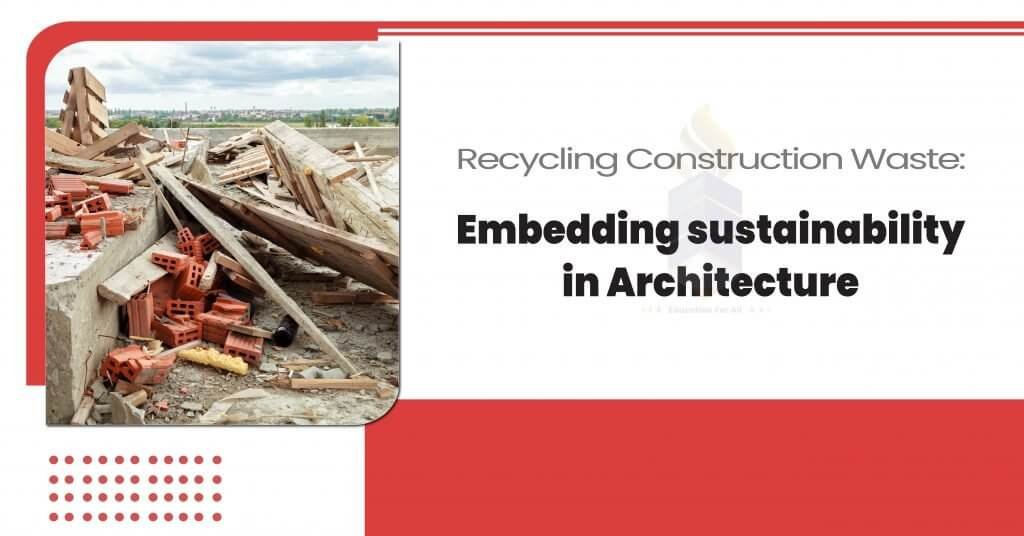Construction industry is one of the major contributors in environmental pollution due to the humongous amount of waste generated on construction sites. The annual construction and demolition waste is estimated to be around 30 million tonnes in India. However only 5% of total waste is recycled as mentioned in Guidelines on environmental management of C&D waste whereas 95% of this waste goes to the landfills which is an alarming scenario. Central Pollution control board defines Construction and Demolition waste as waste comprising of building materials, debris and rubble resulting from construction, re- modeling, repair and demolition of any civil structure. Wastes also include surplus and damaged products and materials arising in the course of construction work or used temporarily during the course of on-site activities. A significant proportion of constructionwaste can be recycled and reused and brought back to construction to substitute naturally sourced material through the concept of circular economy, Thus, reducing the burden on landfills and natural resources for construction.
How can recycling C&D waste be rewarding?
- Reduces burden on natural resources for the supply of sand and aggregate.Recycled aggregates and sand of high quality can replace these naturally sourced building materials.
- Protect natural environments and reserves from unwanted exploitation.
- Can meet the growing requirements for building materials through sustainable means.
- Minimizing transport costs for sand and aggregates sourced from a distance away from the construction sites.
- Reduces the overall carbon footprint of the materials.
As per the waste management rules of 2016, the ministry of environment recommends use of recycled products up to 20% for all new constructions. For the said purpose, there are 13 recycling units operational in India which are set up by different urban local bodies for recycling C&D waste according to a report by Centre for Science and Environment. It is however astonishing to note that Mumbai, being one of the largest City to produce maximum C & D waste due to its huge infrastructure development does not have any C & D waste recycling facility.
Green Initiative in Thane
According to the MPCB annual report on C & D waste management rules, 2016 for the year 2020-2021, total amount of C&D waste generated annually assumed to be 31697 mt tonnes in Thane Municipal corporation. This total amount of waste estimated covers the unauthorized waste dumped along roadsides and other areas like landfills. Thane has one stationary facility set up for recycling C & D waste with a daily capacity of recycling 300 tonnes of C & D waste. The plant is located at the Daighar village on the outskirts of Thane region. This is the first C & D waste recycling plant set up by any Urban Local Body in Mumbai metropolitan region. The Daighar plant is managed and operated by Metrro waste handling Pvt. Ltd company on a 5 acre land provided by the Thane Municipal corporation. This plant started its operations in 2017 by collecting all the C & D waste from Thane city for about two years since its inception. It recycles around 200 tonnes of waste per day. Currently it can be noticed that only 55% of the total waste received is recyclable. Rest is disposed off at the landfills. It is observed that a lot of waste that is collected is in the form of non-segregated waste. This waste upon segregation at the plant, leaves 45% as non recyclable which is sent to the landfills. The facility currently produces recycled sand and aggregates which can be utilized directly as building materials or as raw materials for manufacturing of other recycled products. This initiative however is yet is not known about in the industry. This is majorly due to lack of awareness amongst the stakeholders. Other factors responsible are lack of trust and no confidence amongst the buyers concerning the quality of recycled products.
In an effort to embed sustainability in construction, it is necessary to make policy level changes that mandates the use of recycled products, implementation of BIS standards for manufacturing recycled products, revisions in existing frameworks for management and recycling of C& D waste on site and at the recycling facilities, which can unablearchitects to promote the use of such recycled products alongside being accountable for, reducing and recycling the Construction and demolition waste generated on their sites.

Ar. Persis Rebello
Assistant Professor at Smt. K. L. Tiwari College of Architecture



